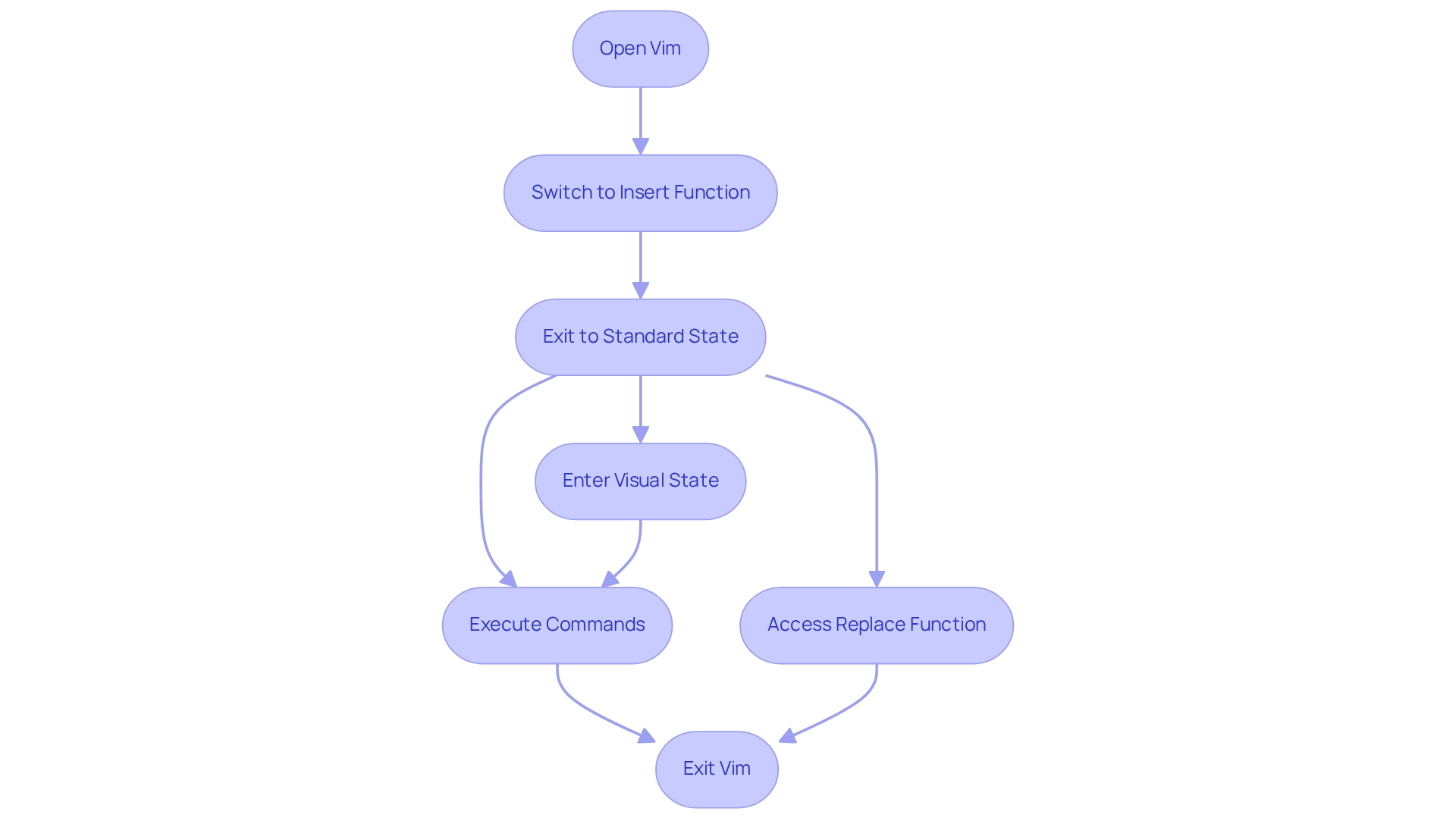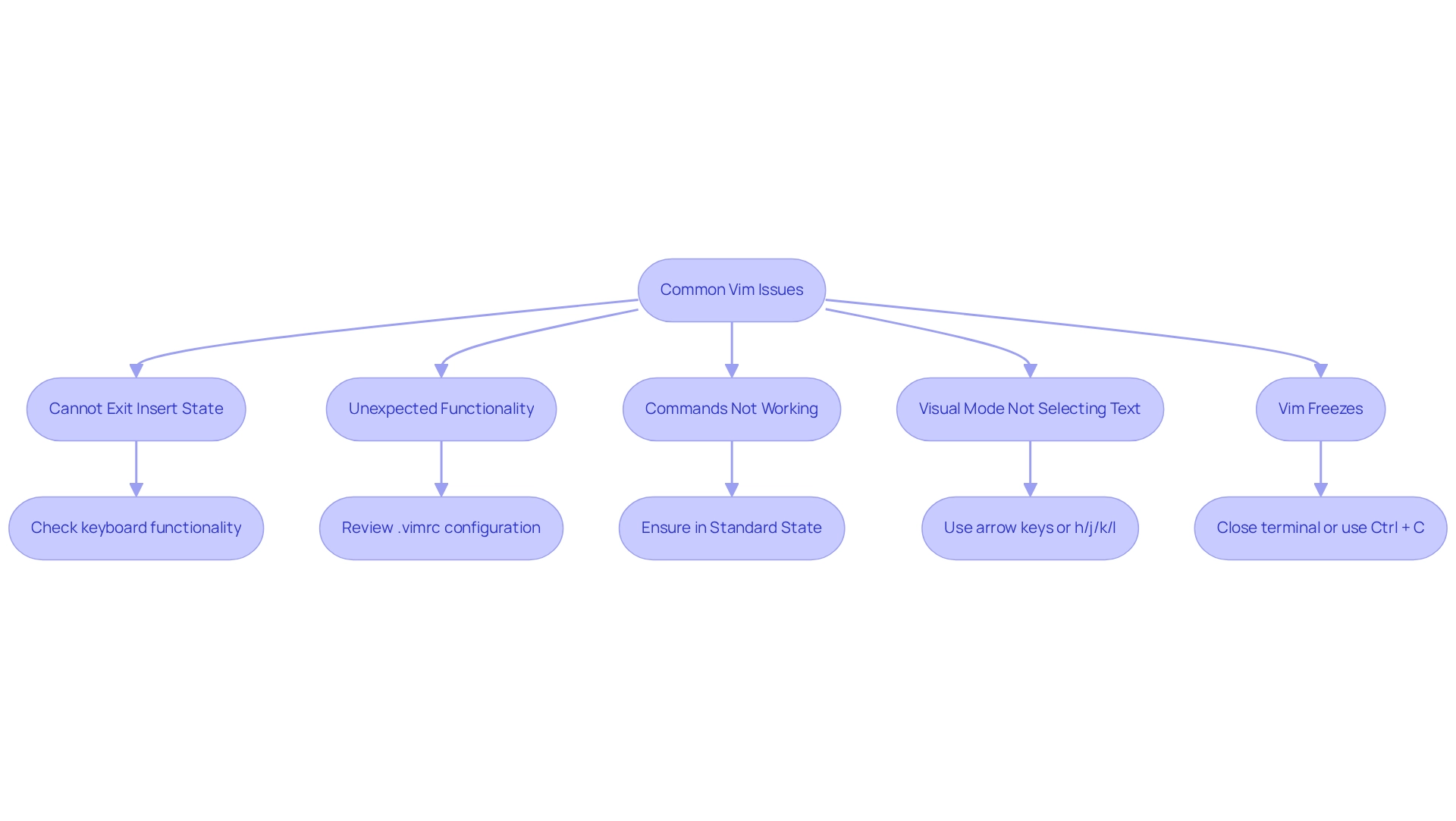Overview
The article begins by addressing the common challenges developers face in coding, capturing the reader's attention. It then introduces how Kodezi effectively tackles these challenges through its specific features, sparking interest. By highlighting the benefits of using Kodezi, such as improved productivity and enhanced code quality, the text fosters a desire for the reader to explore the platform further. Finally, it encourages action by urging readers to take advantage of the tools available, equipping them with practical skills to enhance their coding efficiency.
Introduction
Coding can be a challenging endeavor for many developers, especially when navigating complex text editors. Vim, a powerful text editor favored by many, operates on a unique system of modes that can initially bewilder newcomers. Mastering these modes is essential, as it transforms one's approach to text manipulation and coding efficiency.
From the default Normal Mode to the versatile Insert Mode, each mode serves a distinct purpose that enhances productivity. With statistics showing that around 30% of developers prefer Vim for its streamlined workflow, understanding how to navigate these modes becomes crucial for anyone looking to elevate their coding skills.
This article delves into the intricacies of Vim's modes, offers step-by-step instructions for switching between them, and addresses common troubleshooting issues, ensuring a smoother and more effective coding experience.
Understand Vim Modes
Understanding Vim's various modes, particularly the vim change mode, is essential for effective content manipulation, especially given the challenges developers encounter in coding. Each mode serves a specific purpose:
- Normal Setting is the default when you open Vim, facilitating navigation and command execution without character input, crucial for vim change mode.
- The Insert Function enables content addition, accessed by pressing
i,a, oroto enter vim change mode from Normal Mode. - In the Visual Setting, you can select text by pressing
vto enter vim change mode while in Normal Mode. - The Command-Line Function, activated by
:, lets you execute commands like saving or quitting. - Lastly, the vim change mode allows you to substitute existing content as you type, accessed by pressing
Rin Normal Mode.
Mastering these modes is crucial for enhancing productivity and ensuring a smoother coding experience. Notably, a significant percentage of developers—around 30%—prefer Vim for its efficiency, highlighting its relevance in the programming community. Have you considered how mastering Vim could elevate your coding skills? Practical suggestions, such as using lowercase 'p' to paste content after the cursor and uppercase 'P' to paste before, can significantly boost your productivity in vim change mode. As Tanishka Makode emphasizes, understanding tools like Vim is vital for skill enhancement. Furthermore, insights from case studies reveal that a solid grasp of vim change mode not only enhances productivity but also contributes to a more efficient coding workflow.

Change Modes in Vim: Step-by-Step Instructions
Changing modes in Vim can initially seem challenging, but with these straightforward steps to enter vim change mode, you'll navigate it effortlessly.
- Open Vim: Begin by launching a terminal and typing
vim filenameto open your desired file. - Switch to Insert Function: Press
ito enter Insert Function, allowing you to type text just as you would in any standard text editor. - To exit Insert State and return to Standard State, simply press the
Esckey to activate vim change mode. - Enter Visual State: While in Standard State, press
vto switch to vim change mode, which allows you to select text using the arrow keys. - Execute Commands: To access vim change mode, press
:in Standard State. Here, you can type your command (for example,wqto save and quit) and hitEnter. - Access Replace Function: In Standard State, pressing
Rallows you to replace existing text as you type. - Exit Vim: Finally, to leave Vim, ensure you are in Standard State and type
:qto quit, or:wqto save and exit.

Troubleshoot Common Issues in Vim Mode Switching
The challenges developers face when switching modes in Vim, especially during the vim change mode, can significantly impact their coding efficiency. Understanding these common issues is essential for enhancing your coding workflow with Kodezi.
- Cannot Exit Insert State: If pressing
Escfails to return you to Standard State, first check your keyboard functionality, as external keyboards may sometimes cause issues. - Unexpected Functionality: If Vim seems to start in an unexpected mode, such as Replace Functionality, review your
.vimrcconfiguration file for any settings that might enforce this behavior. - Commands Not Working: Ensure you are in Standard State; pressing
Escwill take you back to Normal mode before executing commands. - Visual Mode Not Selecting Text: When in Visual Mode, make sure to utilize the arrow keys or
h,j,k,lfor navigation to select text effectively. - If Vim freezes or becomes unresponsive, try closing the terminal or using
Ctrl + Cto interrupt the process; restarting Vim may help resolve the issue, as many users experience difficulties with vim change mode. However, with practice, many developers report mastering these commands within just a few weeks. This aligns with Kodezi's mission to improve workflow and productivity for developers. As Yash Ranadive suggests, when encountering unfamiliar terms, utilize the:helpcommand for assistance. By addressing these common challenges, users can significantly enhance their coding experience and overall development workflow. Furthermore, delving deeper into Vim can greatly expand your coding capabilities, especially when paired with Kodezi's features, such as seamless code translation and the Kodezi CLI, which enables teams to auto-heal codebases and streamline their development processes.

Conclusion
Mastering Vim is crucial for developers facing the challenges of coding efficiency and productivity. By grasping the distinct modes—Normal, Insert, Visual, Command-Line, and Replace—users can navigate and manipulate text more effectively. Each mode serves a specific purpose, facilitating a streamlined workflow that many developers appreciate; indeed, around 30% prefer using Vim.
Switching between these modes is straightforward, achievable with just a few keystrokes. The step-by-step instructions create a clear pathway for users to transition seamlessly, allowing them to focus on coding without unnecessary interruptions. Furthermore, addressing common troubleshooting issues mitigates potential frustrations during mode switching, fostering a smoother and more enjoyable coding experience.
Ultimately, embracing the intricacies of Vim can significantly elevate a developer's skillset. By investing time in mastering these modes and troubleshooting effectively, developers unlock the full potential of this powerful text editor. As the programming landscape evolves, the ability to navigate tools like Vim efficiently remains a valuable asset in the pursuit of coding excellence.
Frequently Asked Questions
What are the different modes in Vim?
Vim has several modes, including Normal Mode, Insert Mode, Visual Mode, Command-Line Mode, and Change Mode. Each mode serves a specific purpose for content manipulation and navigation.
What is Normal Mode in Vim?
Normal Mode is the default mode when you open Vim. It allows for navigation and command execution without character input, which is essential for accessing other modes, including Change Mode.
How can I enter Insert Mode in Vim?
You can enter Insert Mode by pressing i, a, or o while in Normal Mode. This mode enables you to add content.
What is Visual Mode in Vim?
Visual Mode allows you to select text. You can enter this mode by pressing v while in Normal Mode.
How do I use Command-Line Mode in Vim?
You can activate Command-Line Mode by pressing :. This mode lets you execute commands such as saving or quitting Vim.
What is Change Mode in Vim?
Change Mode allows you to substitute existing content as you type. You can access this mode by pressing R in Normal Mode.
Why is mastering these modes important for developers?
Mastering these modes enhances productivity and ensures a smoother coding experience, making it easier to manipulate content effectively.
How does Vim's popularity among developers reflect its utility?
Approximately 30% of developers prefer Vim for its efficiency, indicating its relevance and utility in the programming community.
What are some practical tips for using Change Mode effectively?
Practical tips include using lowercase 'p' to paste content after the cursor and uppercase 'P' to paste before the cursor, which can significantly boost productivity in Change Mode.




